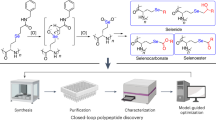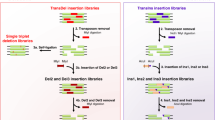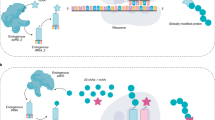Abstract
A family of engineered endopeptidases has been created that is capable of cleaving a diverse array of peptide sequences with high selectivity and catalytic efficiency (kcat/KM > 104 M−1 s−1). By screening libraries with a selection-counterselection substrate method, protease variants were programmed to recognize amino acids having altered charge, size and hydrophobicity properties adjacent to the scissile bond of the substrate, including Glu↓Arg, a specificity that to our knowledge has not been observed among natural proteases. Members of this artificial protease family resulted from a relatively small number of amino acid substitutions that (at least in one case) proved to be epistatic.
This is a preview of subscription content, access via your institution
Access options
Subscribe to this journal
Receive 12 print issues and online access
$259.00 per year
only $21.58 per issue
Buy this article
- Purchase on Springer Link
- Instant access to full article PDF
Prices may be subject to local taxes which are calculated during checkout



Similar content being viewed by others
References
Overall, C.M. & Blobel, C.P. In search of partners: linking extracellular proteases to substrates. Nat. Rev. Mol. Cell Biol. 8, 245–257 (2007).
Kuranaga, E. & Miura, M. Nonapoptotic functions of caspases: caspases as regulatory molecules for immunity and cell-fate determination. Trends Cell Biol. 17, 135–144 (2007).
Page-McCaw, A., Ewald, A.J. & Werb, Z. Matrix metalloproteinases and the regulation of tissue remodelling. Nat. Rev. Mol. Cell Biol. 8, 221–233 (2007).
Yamada, T., Shimada, Y. & Kikuchi, M. Integrin-specific tissue-type plasminogen activator engineered by introduction of the Arg-Gly-Asp sequence. Biochem. Biophys. Res. Commun. 228, 306–311 (1996).
Jenny, R.J., Mann, K.G. & Lundblad, R.L. A critical review of the methods for cleavage of fusion proteins with thrombin and factor Xa. Protein Expr. Purif. 31, 1–11 (2003).
Turkina, M.V. & Vener, A.V. Identification of phosphorylated proteins. Methods Mol. Biol. 355, 305–316 (2007).
Marnett, A.B. & Craik, C.S. Papa's got a brand new tag: advances in identification of proteases and their substrates. Trends Biotechnol. 23, 59–64 (2005).
Ballinger, M.D., Tom, J. & Wells, J.A. Furilisin: a variant of subtilisin BPN' engineered for cleaving tribasic substrates. Biochemistry 35, 13579–13585 (1996).
Hedstrom, L., Szilagyi, L. & Rutter, W.J. Converting trypsin to chymotrypsin: the role of surface loops. Science 255, 1249–1253 (1992).
Hopfner, K.P. et al. New enzyme lineages by subdomain shuffling. Proc. Natl. Acad. Sci. USA 95, 9813–9818 (1998).
Khersonsky, O., Roodveldt, C. & Tawfik, D.S. Enzyme promiscuity: evolutionary and mechanistic aspects. Curr. Opin. Chem. Biol. 10, 498–508 (2006).
Kukkonen, M. & Korhonen, T.K. The omptin family of enterobacterial surface proteases/adhesins: from housekeeping in Escherichia coli to systemic spread of Yersinia pestis. Int. J. Med. Microbiol. 294, 7–14 (2004).
McCarter, J.D. et al. Substrate specificity of the Escherichia coli outer membrane protease OmpT. J. Bacteriol. 186, 5919–5925 (2004).
Walton, T.A. & Sousa, M.C. Crystal structure of Skp, a prefoldin-like chaperone that protects soluble and membrane proteins from aggregation. Mol. Cell 15, 367–374 (2004).
Varadarajan, N., Gam, J., Olsen, M.J., Georgiou, G. & Iverson, B.L. Engineering of protease variants exhibiting high catalytic activity and exquisite substrate selectivity. Proc. Natl. Acad. Sci. USA 102, 6855–6860 (2005).
Hwang, J.K. & Warshel, A. Why ion pair reversal by protein engineering is unlikely to succeed. Nature 334, 270–272 (1988).
Graf, L. et al. Selective alteration of substrate specificity by replacement of aspartic acid-189 with lysine in the binding pocket of trypsin. Biochemistry 26, 2616–2623 (1987).
Caputo, A., Parrish, J.C., James, M.N., Powers, J.C. & Bleackley, R.C. Electrostatic reversal of serine proteinase substrate specificity. Proteins 35, 415–424 (1999).
Vandeputte-Rutten, L. et al. Crystal structure of the outer membrane protease OmpT from Escherichia coli suggests a novel catalytic site. EMBO J. 20, 5033–5039 (2001).
Barrett, A.J.R., Neil, D. & Woessner, J.F. Handbook of Proteolytic Enzymes 1–1666 (Academic Press, London, 1998).
Hwang, B.Y. et al. Substrate specificity of the Escherichia coli outer membrane protease OmpP. J. Bacteriol. 189, 522–530 (2007).
Dawson, K.M. et al. Plasminogen mutants activated by thrombin. Potential thrombus-selective thrombolytic agents. J. Biol. Chem. 269, 15989–15992 (1994).
Gardell, S.J. et al. Isolation, characterization, and cDNA cloning of a vampire bat salivary plasminogen activator. J. Biol. Chem. 264, 17947–17952 (1989).
Peschel, A. & Sahl, H.G. The co-evolution of host cationic antimicrobial peptides and microbial resistance. Nat. Rev. Microbiol. 4, 529–536 (2006).
Stumpe, S., Schmid, R., Stephens, D.L., Georgiou, G. & Bakker, E.P. Identification of OmpT as the protease that hydrolyzes the antimicrobial peptide protamine before it enters growing cells of Escherichia coli. J. Bacteriol. 180, 4002–4006 (1998).
Park, H.S. et al. Design and evolution of new catalytic activity with an existing protein scaffold. Science 311, 535–538 (2006).
Collins, C.H., Leadbetter, J.R. & Arnold, F.H. Dual selection enhances the signaling specificity of a variant of the quorum-sensing transcriptional activator LuxR. Nat. Biotechnol. 24, 708–712 (2006).
Santoro, S.W., Wang, L., Herberich, B., King, D.S. & Schultz, P.G. An efficient system for the evolution of aminoacyl-tRNA synthetase specificity. Nat. Biotechnol. 20, 1044–1048 (2002).
Segers, K., Dahlback, B. & Nicolaes, G.A. Coagulation factor V and thrombophilia: background and mechanisms. Thromb. Haemost. 98, 530–542 (2007).
Grodberg, J., Lundrigan, M.D., Toledo, D.L., Mangel, W.F. & Dunn, J.J. Complete nucleotide sequence and deduced amino acid sequence of the ompT gene of Escherichia coli K-12. Nucleic Acids Res. 16, 1209 (1988).
Fromant, M., Blanquet, S. & Plateau, P. Direct random mutagenesis of gene-sized DNA fragments using polymerase chain reaction. Anal. Biochem. 224, 347–353 (1995).
Hoover, D.M., Wu, Z., Tucker, K., Lu, W. & Lubkowski, J. Antimicrobial characterization of human beta-defensin 3 derivatives. Antimicrob. Agents Chemother. 47, 2804–2809 (2003).
Acknowledgements
We thank G. Skretas and J. Link for reading the manuscript, J. Borrock and M. Pogson for assistance in preparing the graphical abstract and K. Griswold for many helpful discussions. We also thank E. Farinas for the initial design of the primers. This work was supported by US National Institutes of Health grants R01 GM065551 and RO1 GM073089.
Author information
Authors and Affiliations
Contributions
N.V., B.L.I. and G.G. designed the research. B.-Y.H. ran the substrate-phage experiments; N.V. ran all the other experiments. S.R. assisted N.V. with library construction and kinetic characterization. N.V., B.L.I. and G.G. wrote the manuscript.
Corresponding authors
Supplementary information
Supplementary Text and Figures
Supplementary Figures 1–5, Supplementary Tables 1 and 2, and Supplementary Methods (PDF 354 kb)
Rights and permissions
About this article
Cite this article
Varadarajan, N., Rodriguez, S., Hwang, BY. et al. Highly active and selective endopeptidases with programmed substrate specificities. Nat Chem Biol 4, 290–294 (2008). https://doi.org/10.1038/nchembio.80
Received:
Accepted:
Published:
Issue Date:
DOI: https://doi.org/10.1038/nchembio.80
This article is cited by
-
Evolution of protease activation and specificity via alpha-2-macroglobulin-mediated covalent capture
Nature Communications (2023)
-
Adaptive strategies of uropathogenic Escherichia coli CFT073: from growth in lab media to virulence during host cell adhesion
International Microbiology (2022)
-
Reengineering the specificity of the highly selective Clostridium botulinum protease via directed evolution
Scientific Reports (2022)
-
Desperately seeking sortase
Nature Chemical Biology (2021)
-
Engineered dual selection for directed evolution of SpCas9 PAM specificity
Nature Communications (2021)



